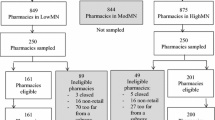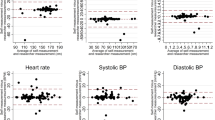Abstract
Background In Qatar, home diagnostic tests are available over the counter in community pharmacies. While possibly beneficial, these tests have the potential for harm if they are used in the absence of pharmacist counseling. Objectives To determine the public views, level of awareness and use of home diagnostic tests and to evaluate the extent of community pharmacists’ involvement in educating the public about these tests in Qatar. Setting Qatar’s Supreme Council of Health lists 245 community pharmacies in Qatar. Ten community pharmacies were randomly selected from the list as study sites. Method The investigators visited selected pharmacies on different weekdays and at different times of the day. Members of the public who appeared to be over 16 years of age and able to communicate in English or Arabic were randomly approached, provided with the study objectives, and requested to participate. Those who offered oral consent were anonymously interviewed using a multipart survey. Main outcome measures Measures include the public awareness and use of home diagnostic tests and the extent of community pharmacist involvement in educating the public about these tests. Results During the 5-month study period, 297 patients answered the survey (60 % response rate). Most respondents were aware of at least one home diagnostic test (98 %). The top four home diagnostic tests that the respondents had ever heard of included: thermometers (91 %), blood pressure monitors (91 %), blood sugar tests (86 %) and regular pregnancy tests (72 %). Seventy-one percent of respondents had performed at least one home diagnostic test. When asked about the factors that influenced their choice of the home diagnostic tests, the pharmacist was only cited by 7 % of respondents. The majority of respondents (>80 %) agreed that using a home diagnostic test is convenient, comfortable and helps them in early diagnosis and treatment of healthcare conditions. Only 31 % agreed that the pharmacist offered sufficient information on what to do in case the test result turns to be positive. The study results suggest that generally, the public has good attitudes and awareness of home diagnostic tests. However, the results indicate that Qatar community pharmacists are not sufficiently involved in public education about home diagnostic tests. Pharmacists should take a more active role in counseling the public on the proper use of these tests.
Similar content being viewed by others
References
Ryan A, Greenfield S, Wilson S. Prevalence and determinants of the use of self-tests by members of the public: a mixed methods study. BMC Public Health. 2006;6(193):1–5.
Ronda G, Portegijs P, Dinant GJ, Buntinx F, Norg R, Weijden T. Use of diagnostic self-tests on body materials among Internet users in the Netherlands: prevalence and correlates of use. BMC Public Health. 2009;9(100):1–6. doi:10.1186/1471-2458-9-100.
Borriello SP. Science, medicine, and the future: near patient microbiological tests. BMJ. 1999;319:298–301.
Wilson S, Ryan AV, Greenfield SM, Clifford SC, Holder RL, Pattison HM, et al. Self-testing for cancer: a community survey. BMC Cancer. 2008;8(102):1–7.
International Pharmaceutical Federation. Statement of principle: self-care including self-medication the professional role of the pharmacist, 1996. [cited 28/4/2012]. Available at: http://www.fip.org/www/uploads/database_file.php?id=204&table_id=.
World Health Organization. The role of the pharmacist in self-care and self-medication, 1998. [cited 28/4/2012]. Available at: http://apps.who.int/medicinedocs/pdf/whozip32e/whozip32e.pdf.
Scolaro KL, Lioyd KB, Helms KL. Devices for home evaluation of women’s health concerns. Am J Health-Syst Pharm. 2008;65(4):299–314.
Quattrocchi A. Helping patients understand home testing devices. Drug Topics. 1988;132(9):65.
Gossel TA. Home testing products for self-monitoring. Am J Hosp Pharm. 1988;45(5):1119–26.
World Health Organization Health System Profile Qatar, 2006. [cited 28/4/2012]. Available at: http://gis.emro.who.int/HealthSystemObservatory/PDF/Qatar/Health%20system%20organization.pdf.
Laws Regulating the Pharmaceutical Profession in Qatar, 2002.
Kheir N, Zaidan M, Younes H, El Hajj M, Wilbur K, Jewesson P. Pharmacy education and practice in 13 Middle Eastern countries. Am J Pharm Educ. 2008;72(6):1–13.
McCallian DJ, Cheigh NH. The pharmacist’s role in self-care. J Am Pharm Assoc (Wash). 2002;42(5 Suppl 1):S40–1.
Ryan A, Ives J, Wilson S, Greenfield S. Why members of the public self-test: an interview study. Fam Pract. 2010;27(5):570–81.
Ickenroth MH, Grispen JE, Ronda G, Tacken M, Dinant GJ, de Vries NK, et al. Motivation and experiences of self-testers regarding tests for cardiovascular risk factors. Health Expect. 2011;doi: 10.1111/j.1369-7625.2011.00733.x.
Wagner EH, Austin BT, Von Koroff M. Improving outcomes in chronic illness. Manag Care Q. 1996;4(2):12–25.
El Hajj M, El Salem S, Mansoor H. Public’s attitudes towards community pharmacy in Qatar: a pilot study. Patient Prefer Adherence. 2011;5:405–22.
El Hajj M, Kheir AN, Al-Zaidan MB, Jewesson PJ. Pharmacist characteristics, medication use perceptions and professional satisfaction: a first national survey in the state of Qatar. J Healthc Leadersh. 2011;3:9–28.
Acknowledgments
The authors wish to thank the pharmacists in the participating pharmacies
Funding
None.
Conflicts of interest
Mr. Diaa Mujahed Sawaftah would like to declare that Masseelah Pharmacy is one of the distributors of home diagnostic tests in Qatar. The other authors of this manuscript have no conflicts of interest to declare.
Author information
Authors and Affiliations
Corresponding author
Rights and permissions
About this article
Cite this article
El Hajj, M.S., EL-Ajez, R.H., Al-Ismail, M.S.M. et al. Home diagnostic tests in the state of Qatar: a snapshot of public views, level of awareness and use. Int J Clin Pharm 34, 885–892 (2012). https://doi.org/10.1007/s11096-012-9687-2
Received:
Accepted:
Published:
Issue Date:
DOI: https://doi.org/10.1007/s11096-012-9687-2




